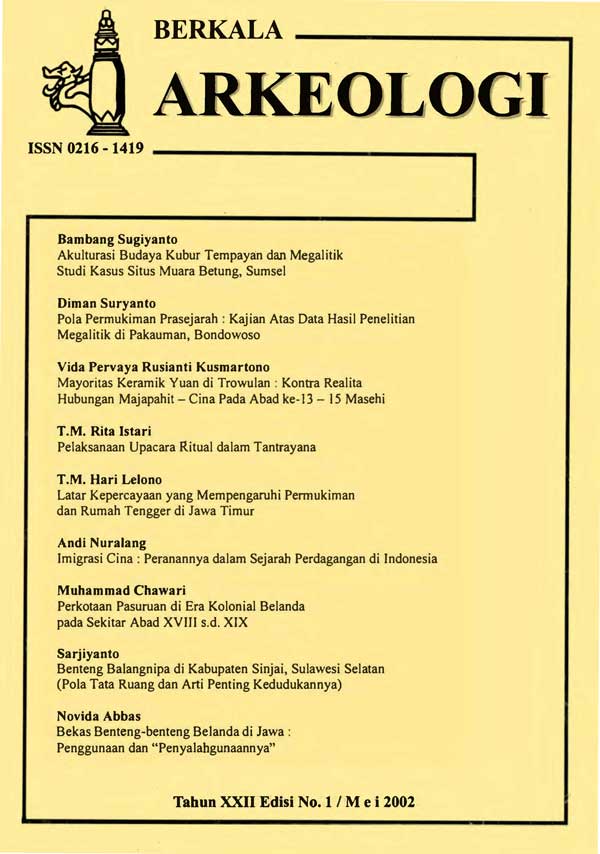PERKOTAAN PASURUAN DI ERA KOLONIAL BELANDA PADA SEKITAR ABAD XVIII S.D. XIX
Main Article Content
Abstract
At the beginning of its existence, Pasuruan was a traditional city that developed due to the influence of the cultural centers that developed around it. These cultural centers include the Singasari Kingdom, the Blambangan Kingdom, the Majapahit Kingdom, and the Mataram Kingdom. In addition, there is a traditional port, which was developed due to the presence of traders from around Pasuruan. The traditional city is centered on a plaza with the regent's office located to the north of the square. Apart from the existence of the Grand Mosque which is located west of the square. Apart from local traders, there are also foreign traders. One of these foreign traders was the Netherlands. The Dutch traders then settled and subsequently made their own colonies according to their interests, namely to maintain their existence. With the presence of foreign traders who settled down, their settlements emerged - eventually becoming a city with all its facilities and amenities.
Article Details

This work is licensed under a Creative Commons Attribution-NonCommercial-ShareAlike 4.0 International License.
References
Abbas, Novida. 1998/1999. Laporan Hasil Penelitian Arekologi Permukiman Etnis Cina di Kota-kota Kuna Bercorak Islam di Jawa Tengah (Tahap II). Yogyakarta: Balai Arkeologi.
Abbas, N., & Dewi, E. R. (1995). Perkembangan Kota Yogyakarta Berdasarkan Peningkatan Pemanfaatan Lahan. Berkala Arkeologi, 15(2), 25–34. https://doi.org/10.30883/jba.v15i2.658
Anonim. 2001. Kabupaten Pasuruan Dalam Angka. Pasuruan: BAPPEDA Kabupaten Pasuruan dan BPS Kabupaten Pasuruan.
Chaldun, Achmad. Tt. Atlas Ilmu Pengetahuan Sosial Jawa Timur. Surabaya: PT. Karya Pembina Swajaya.
Chawari, Muhammad. 2000. Laporan Penelitian Arkeologi Keletakan dan Bentuk-bentuk Makam Belanda Pada Kota-kota Pantai (Tahap III). Yogyakarta: Balai Arkeologi.
Graaf, DR. H.J. De dan Pigeaud, DR. TH. G. TH. 1985. Kerajaan-kerajaan Islam di Jawa. Jakarta: Penerbit PT Grafiti Pers.
Graaf, DR. H.J. de dkk. 1998. Cina Muslim di Jawa Abad XV dan XVI Antara Historisitas dan Mitos. Yogyakarta: Penerbit PT Tiara Wacana.
Kartodirdjo, Sartono. 1992. Pengantar Sejarah Indonesia Baru: 1500-1900. Dari Emporium Sampai lmperium. Jakarta: PT. Gramedia Pustaka Utama.
Lombard, Denys. 1996. Nusa Jawa: Silang Budaya - Jaringan Asia. Buku. 2. Jakarta: Penerbit PT. Gramedia Pustaka Utama.
Ricklefs, M.C. 1995. Sejarah Indonesia Modern. Yogyakarta: Gadjah Mada University Press.
Soekiman, Prof, DR. Djoko. 2000. Kebudayaan lndis Dan Gaya Hidup Masyarakat Pendukungnya di Jawa Abad XVIII - Medio Abad XX. Yogyakarta: Penerbit Yayasan Bentang Budaya, Cetakan Pertama.
Tjiptoatmodjo, F.A Sutjipto. 1983. Kota-kota Pantai di Sekitar Selat Madura (Abad XVII s.d. Medio Abad XIX). Yogyakarta: Disertasi pada Universitas Gadjah Mada.
Wibisono, Sonny. Chr. 1992. Emas di Kalimantan Baral: Kajian Etnohistori Untuk Arkeologi. PIA IV. Malang.
Widodo, Johannes. Chinese Settlement in a Changing City: An Architectural Study of the Urban Chinese Settlement in Semarang, Indonesia. Thesis. Leuven. Katholieke Universiteit.

